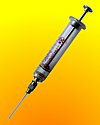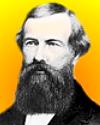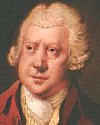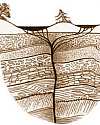
On 3 Aug 1875, Robert Ernest House was born, who convinced himself that scopolamine hydrobromide could be reliably used in criminology, after which he promoted its use, and it became known as a “truth serum.”
You can read about the news coverage of his presentation on its successful application in this article 'Truth Serum' Test Proves Its Power, as described in the New York Times in 1924.

On 3 Aug 1900, John T. Scopes was born, who became the defendant in the infamous Scopes Monkey Trial. Today's book pick is: Center of the Storm: Memoirs of John T. Scopes, by John Thomas. Scopes. These are the recollections of the soft-spoken defendant in the celebrated trial, accused of violating the egregious Tennessee "Butler Act". He gives a unique perspective on the trial. He attempts to set the record straight in some respects. Of course, it might have been called the Charles Darwin trial for all it mattered who was the real defendant in the courtroom. For Scopes the trial was never a question of choosing between evolution and Genesis, but rather in defending the freedom of teachers to teach and students to learn. As far as he was concerned both sides could believe what they wished, but they could not force their beliefs upon others. Scope's recollections of Darrow and Bryan are particularly insightful.
It is available from Amazon, typically about New from $821.29. Used from $9.44. (As of earlier time of writing - subject to change.)
 | I have always found small mammals enough like ourselves to feel that I could understand what their lives would be like, and yet different enough to make it a sort of adventure and exploration to see what they were doing. |
 | The suppression of crime is not entirely a legal question. It is a problem for the physician, the economist and the lawyer. We, as physicians, should encourage the criminologist by lending to him the surgeon, the internist and all of the rest of the resources of medicine, just as we have done in the case of the flea man, the fly man, the mosquito man, the bed-bug man and all the other ologists. |
| Before you look at today's web page, see if you can answer some of these questions about the events that happened on this day. Some of the names are very familiar. Others will likely stump you. Tickle your curiosity with these questions, then check your answers on today's web page. | |
| Births | |
 | Donald Redfield Griffin, born 3 Aug 1915, is an American biophysicist and animal behaviourist who researched in animal navigation, acoustic orientation, and sensory biophysics. During WW II, he applied physiological principles to design military equipment such as cold-weather clothing and headphones. In 1938, he began studying bat ecolocation, or how could the bat ears replace eyes in flight guidance. Working with G.W. Pierce, and specialized high-frequency sound equipment, they found that bats were issuing sounds. The horseshoe bat’s frequency range of 60-120 kHz is well above the limit of human hearing (15-20 kHz). Griffin also worked extensively on bird navigation. In the late 1940s, he observed the flight paths of gannets and gulls. How did he observe the flight paths of these birds? |
 | An American inventor, born 3 Aug 1811, devised the safety passenger elevator. Can you name this inventor? |
| Deaths | |
 | Emile Berliner (1851-1929) was a German-born American inventor who made important contributions to telephone technology and with an invention in a different area, replaced one of Edison’s household inventions. What household item did Berliner improve over Edison? |
 | Sir Richard Arkwright (1732-1792) was an English textile industrialist and inventor whose use of power-driven machinery and employment of a factory system of production were perhaps more important than his inventions. Nevertheless, Arkwright’s invention, known as the Water Frame was an important contribution to the industry. What was the function of the Water Frame? |
| Events | |
 | On 3 Aug of a certain year, the first crop dusting from an airplane occurred when John Macready used an airplane to dust a six acre grove in Troy, Ohio to kill caterpillars. In which decade did this take place? |
 | On 3 Aug 1769, The La Brea Tar Pits were first noticed by European explorers. They became a prolific source of large animal fossils. Where are the La Brea Tar Pits? |
Fast answers for the previous newsletter for August 2: telephone • the scattering of light by small particles of water in the atmosphere • English Channel • Alexander Graham Bell • wire rope powered by a steam engine • natural hog bristles were replaced nylon.
 If you enjoy this newsletter, the website, or wish to offer encouragement or ideas, please send feedback by using your mail reader Reply button.
If you enjoy this newsletter, the website, or wish to offer encouragement or ideas, please send feedback by using your mail reader Reply button. Your click on a Facebook, StumbleUpon, or other social button on the site webpages is also a welcome sign of appreciation. Thank you for using them.
© This newsletter is copyright 2020 by todayinsci.com. Please respect the Webmaster's wishes and do not put copies online of the Newsletter — or any Today in Science History webpage. (If you already have done so, please remove them. Thank you.) Offline use in education is encouraged such as a printout on a bulletin board, or projected for classroom viewing. Online, descriptive links to our pages are welcomed, as these will provide a reader with the most recent revisions, additions and/or corrections of a webpage. For any other copyright questions, please contact the Webmaster by using your mail reader Reply button.
--
If you do not want to receive any more newsletters, Unsubscribe
To update your preferences and to unsubscribe visit this link
Executive Real Estate Business Class
-
"It was like a man with wings. It wasn't like anything you'd see on TV or in a monster movie." ...
About the publisher
Search This Blog
Blog Archive
-
▼
2021
(585)
-
▼
August
(32)
- Newsletter for Tuesday 31 August.
- Newsletter for Monday 30 August.
- Newsletter for Sunday 29 August.
- Newsletter for Saturday 28 August.
- Newsletter for Friday 27 August.
- Newsletter for Thursday 26 August.
- Newsletter for Wednesday 25 August.
- Newsletter for Tuesday 24 August.
- Newsletter for Monday 23 August.
- All-New Tonight: 'The Machines That Built America'
- Newsletter for Sunday 22 August.
- Newsletter for Saturday 21 August.
- Newsletter for Friday 20 August.
- Newsletter for Thursday 19 August.
- Newsletter for Wednesday 18 August.
- Newsletter for Tuesday 17 August.
- Newsletter for Monday 16 August.
- Newsletter for Sunday 15 August.
- Newsletter for Saturday 14 August.
- Newsletter for Friday 13 August.
- Newsletter for Wednesday 11 August.
- Newsletter for Tuesday 10 August.
- Newsletter for Monday 9 August.
- All-New Tonight 9/8c: Telephone Wars
- Newsletter for Sunday 8 August.
- Newsletter for Saturday 7 August.
- Newsletter for Friday 6 August.
- Newsletter for Thursday 5 August.
- Newsletter for Wednesday 4 August.
- Newsletter for Tuesday 3 August.
- Newsletter for Monday 2 August.
- Newsletter for Sunday 1 August.
-
▼
August
(32)
-
Blogroll
-
About
HistoryFact










0 comments:
Post a Comment